The difficulties of managing a hybrid workforce are easing, but many companies want to entice workers back to the office. Keeping them there, however, isn’t always easy.
Commercial interior design trends reflect these challenges. See what’s new in corporate design for 2023 and beyond, and how businesses leverage furniture solutions to create an inviting and productive atmosphere.
GET INSPIRED: The Ultimate Commercial Interior Design Idea Guide
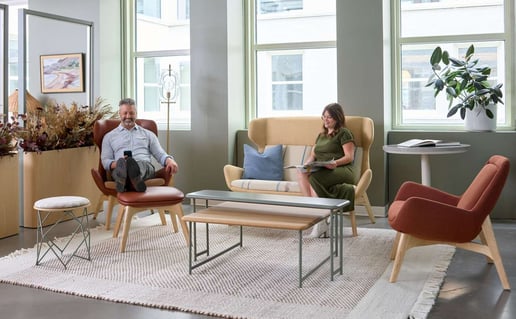
Credit: OFS Brands
“Resimmercial” nods at the fusion of residential and commercial design concepts. Employees are accustomed to working from their living rooms, kitchen tables, or other home office setups. Recreating this comfort level and accommodating work-setting choices that feel more homelike is critical to attract and keep workers. These types of flexible and collaborative commercial spaces also demonstrate a company’s ability to adapt as their employees’ needs change.
Organizations are also providing personalized spaces where individuals can focus without interruptions. Businesses should expect increasing pressure to reconfigure their work environments and provide choices that are as comfortable and inviting as their employees’ homes.
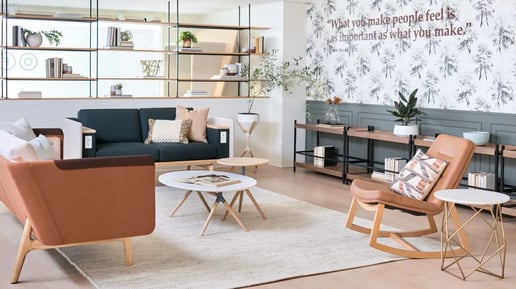
Credit: Herman Miller
After years of looking at light gray walls, flooring, and cabinetry, designers are using richer, warmer neutrals to help create a more relaxed, cozy, and inviting atmosphere. Even when gray is used, it won’t be the cold, sterile look that’s been so popular in the past. Pops of subtle and bold colors are being added, including hues of gold, sage green, faded indigo, and desert tones, whether as accent pieces or accessories.
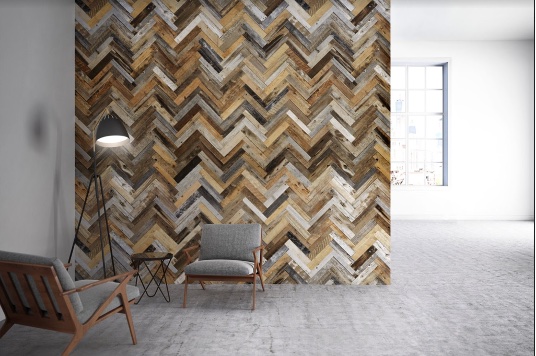
Credit: Vantage; Heraldry by StackedWoodWalls.com
Nature-inspired themes will continue to be popular in 2023. Light-colored and rustic wood finishes add a soft, natural feel to an office setting. Accent walls, furnishings, flooring, cabinetry, and more are often constructed of look-alike vinyl or composite materials that are easy to clean and durable enough for commercial applications. It’s out with dust-magnet fake plants and in with lush, living greenery that helps to soften a look and also improve air quality.
To balance natural materials, plaids, hexagons, diamonds, chevrons, and other geometric shapes add a whimsical yet sophisticated look. Expect to see larger patterns used as accents and incorporated into statement pieces, walls, and flooring.
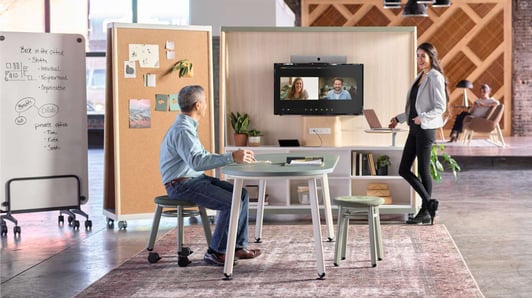
Credit: OFS Brands
Connectivity is critical for business, especially among hybrid teams who rely on video conferencing, chat, phone, apps, and more. Organizations know the value of investing in technology integrations that support their workforces. What’s sometimes overlooked, however, is the relationship between technology and furnishings.
Intentional design and furniture selection can help ensure that unsightly cords don’t take away from work areas and that outlets are properly placed. Another consideration is making sure there is adequate power to run the numerous technologies used in today’s office spaces.
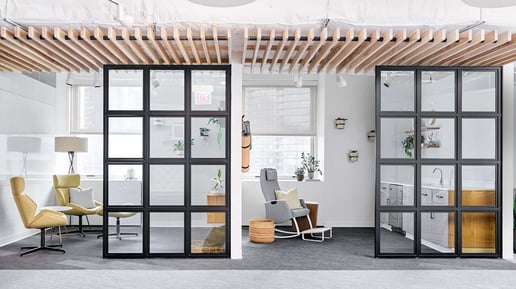
Credit: OFS Brands
In recent years, some corporations have placed an emphasis on cleanability and infection control, ushering in a new age of vinyl. But flat, slippery, glossy finishes are a thing of the past. Advances in commercial fabric technology allow organizations to easily clean surfaces while still enjoying the look and feel of textured upholstery.
Visual dimension is being added to more than just furniture. Textured wallcoverings, window treatments, accessories, and more help to bring a homey, eclectic look to the workplace. Mixing materials, such as marble, glass, metal, wood, and stone provide contrasting textures and greater interest.
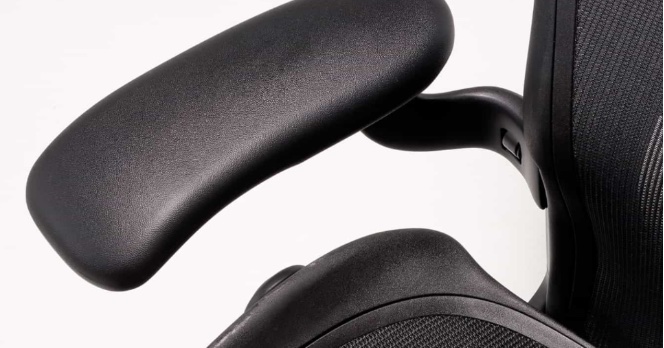
Credit: Herman Miller
Reducing their environmental footprint is a major objective for many businesses. Manufacturers of commercial interior furnishings and finishes offer products that support those initiatives. Herman Miller features a version of their classic Aeron chair made of recycled materials, helping to eliminate an astonishing 234 metric tons of ocean-bound plastic annually.
Another innovator is Interface, a commercial flooring manufacturer that offers carbon-neutral carpet tiles and luxury vinyl products. Pricing for planet-friendly products is becoming more competitive, helping to strengthen their position in the marketplace and make them more accessible for the average business.
A trend that aligns with sustainability is vintage and retro design elements. Watch for these designs to show up in the form of mid-century modern furnishings and fixtures.
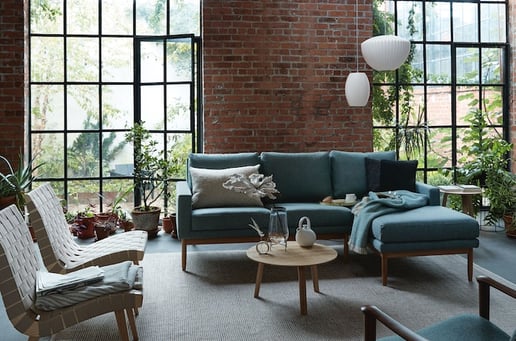
Credit: Design Within Reach
Pillows, accent rugs, soft draperies, artwork, table lamps, and lots of accessories are adorning office spaces. Incorporating residential elements into employee workspaces helps create a sense of home. Using local artists, photography, and murals that represent the community is a higher priority, and including branding on etched glass, partitions, and wall coverings is a growing trend. Strategic placement of artwork and structural decorative elements is an important consideration during the planning phase of a remodeling or construction project.
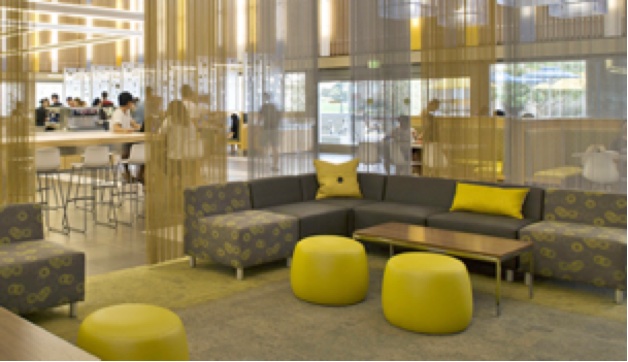
Credit: Momentum Textiles
Open concept office spaces are still on trend, but controlling sound is critical. Curtains aren’t featured solely as decorative accessories; they’re also used to help dampen sound and create privacy for glass-walled conference rooms, work pods, and other areas.
Drapery panels made of commercial-grade fabrics are relatively inexpensive and help to create flexible spaces when placed on tracks for easy opening and closing. Additional sound-dampening features might include decorative acoustical wall or ceiling panels, carpeting, upholstery, and other soft furnishings.
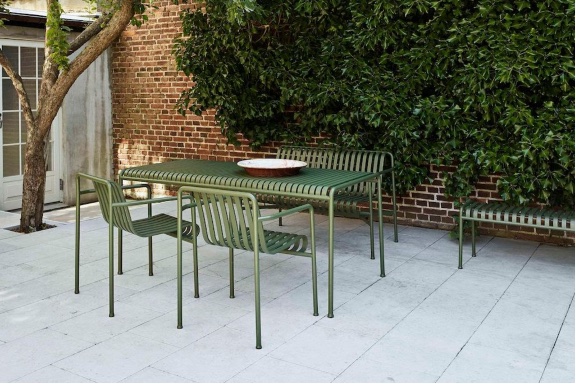
Credit: Herman Miller — HAY
Outdoor activities increased considerably in the recent years, including working on a porch, patio, or park bench. Organizations are renovating outdoor spaces as yet another option for employees to work where they feel most productive and can enjoy the fresh air. Biophilic design — the concept of increasing connectivity to the natural environment — can also improve collaboration and ideation. It’s time to pitch the picnic tables and offer functional and fashionable outdoor spaces for employees.
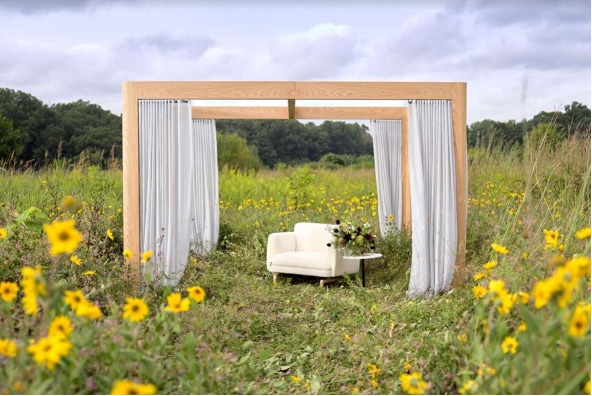
Credit: OFS Brands
Studies suggest that natural light helps to improve productivity and worker satisfaction, but you don’t necessarily need to replace the windows. Strategically placed mirrors can make a significant impact, as can the furnishings you choose. Consider including glass coffee tables and lighter wall colors to maintain an airy, light feel. And don’t forget the quickest way to increase the amount of light in your space: keep the windows clean.
For more ideas on how to enhance and improve your business interior to be both functional and fashionable for today’s hybrid work model, download our complimentary Guide to Commercial Interior Design below.
The talented interior designers and furniture solutions specialists at The Samuels Group are happy to help with your next project. Reach out to them today to learn how they can help you turn your organization into a place that employees are eager to come to every day.
These stories on Furniture Solutions